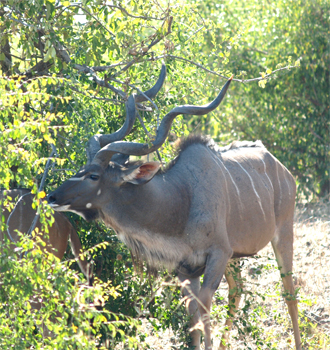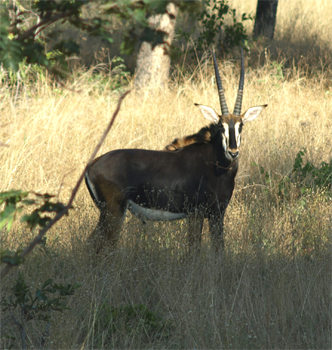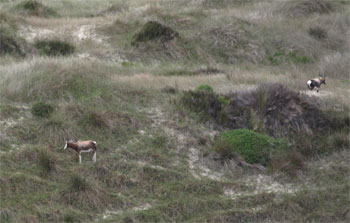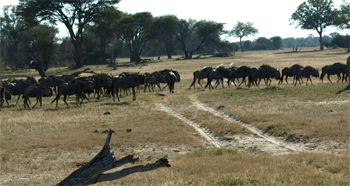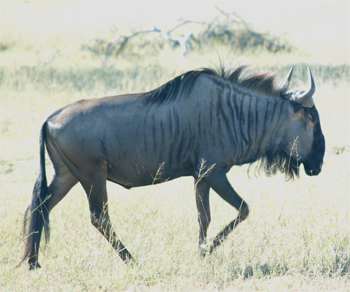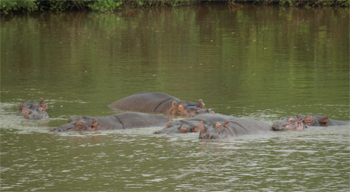We saw many different species of antelope in all of the parks. The most common was the Impala. These small, beautiful, noisy creatures are all over the place in large numbers - more like seeing large herds of cattle on ranch land than seeing a group of wild animals in this country.
Poster boy
|
The Impala is easy to distinguish from many of the other small antelope because it has the McDonald's "golden arches" in black on its rear end and tail.
|
These two are having a friendly discussion
|
Could also be youngsters practicing |
Beautiful, big ears
|
Distinctive markings and nice horns |
|
On the left. A long line of Impala returning from getting a drink in the Chobe River. A good example of the size of some of the herds. For such a small animal, you can't believe the noise they make - often all night long. It is a very loud snorting sound - very distinctive.
|
The Nyala - we saw these only in Kruger NP |
Female Nyala is quite different in appearance from the male
|
The Kudu males have beautiful spiraling horns. The Kudu is distinguished from the Nyala by the hump that it has on its back.
|
Female Kudu - she also has beautiful, big ears. |
Mommy and baby Kudu
|
Lunch time - also notice the Red-billed Ox Pecker on mother's back |
Waterbuck
|
The Waterbuck can always be distinguished by the white circle on its rump. For this reason, it is often called the "toilet-seat" antelope.
|
Waterbuck
|
|
The Puku, which we saw mostly in Kafue NP in Zambia, looks a lot like the Impala. |
The Puku doesn't have the really distinctive side markings and no "golden arches" on its rear end.
|
Sable Antelope - beautiful animal seen in Chobe National Park
|
|
|
The Steenbok is a very small antelope, smaller than most of the brush it hides in. They are very hard to see. They also have those beautiful, big ears.
|
The Eland, one of the largest of the antelope and sort of a recluse when people and cameras are around.
|
|
Wildebeest
|
We saw the most Wildebeest in Hwange NP in Zimbabwe. This is a large member of the antelope family who is also called a Gnu.
|
Part of a very large herd that crossed out path in Hwange NP |
Another nice specimen
|
Wildebeest and bird friends |
This one didn't make it
|
I think that the giraffes are our most favorite animal of all. They are such unusual looking animals - great long necks, strange heads, crazy gait which none the less gets them to where they need to go. They are so curious - constantly peering down at these equally crazy creatures in the noisy vehicles who come to stare at them.
Poster boy
|
We drove a long way to see this guy, our first giraffe in Kruger NP
|
We saw many groups of Giraffes in Chobe NP |
My, how long is your reach!
|
It is a good thing I am tall and have a long tongue!
|
Eating and drinking become interesting tasks for one so tall. On the one hand, you can get at food no one else can reach but when you need a drink it is a long way down and you put yourself in a very vulnerable position. Giraffes have a very long, blue tongue which they use to strip leaves off the trees and shrubs. They do nearly as much damage to the vegetation as do the elephants.
|
A long ways down! The birds also like the Giraffes. |
Reaching down to the top of the bushes. |
Synchronization |
Mommy and babies?
|
Peek-a-boo |
I walk kind of funny, too
|
Another poster boy |
The Giraffe's markings are both beautiful and unique to each individual.
|
Another strange animal with a face only a mother could love. Also, another fairly dangerous animal both in water, where they can easily upset your boat, and on land where they can move much faster than you would imagine. Fortunately, we did not get to test either of these characteristics.
Poster boy
|
Time for a snooze |
Enjoying the cool water |
What a big mouth you have!
|
The Red-billed Ox Pecker really likes the Hippos
|
Babies start out small |
Looks like mother instructing her teenager |
Making more Hippos
|
|
Our Pafuri guide, Trevor, told us the fable of why the hippo spends his days submerged in the water and why he scatters his "poo." African legend says the hippo was created to cut grass for the other animals. The hippo asked if she could stay in the water during the hot days, but God feared that she would eat all the fish. The hippopotamus promised not to, so God agreed. To this day she keeps her promise, dwelling in the water during the day and emerging to eat grass in the cool night air. She scatters her dung in the water by swishing her tail and breaking it up for the fish to eat instead of her eating the fish. Hippos also make a lot of noise at night. Especially at Kafue, we were entertained most of the night by the Hippos in the river and you had to be careful on the path to and from the dining area lest you run into one.
|
| Return to Top | Return to Animals List | Return to Itinerary | Return to Dreamcatcher Home Page |









